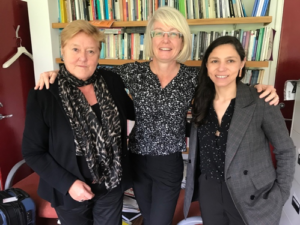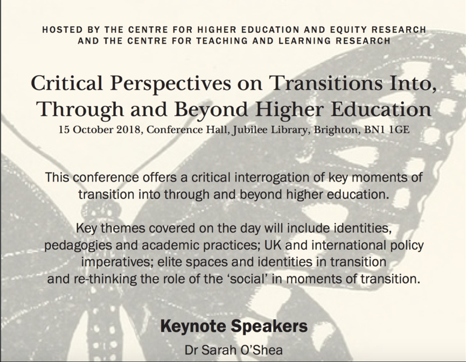
The University of Brighton is the home for the Centre for Higher Education Equity Research (CHEER), whose objective is to research the ‘systems, structures, cultures, experiences and consequences of inequities within higher education’. I was able to chat with Dr Emily Danvers, Dr Tamsin Hinton-Smith and also, Professor Louise Morley (Head of CHEER) to reflect upon their work broadly in the HE sector and also the research conducted that is particularly relevant to the first in family cohort. CHEER also have a number of visiting scholars including Dr Ana Luisa Muñoz-Garcia from Chile who was also able to spend some time discussing the particular contexts of first-in-family students in Chile.

During my visit I was also invited to do the opening key note for a CHEER conference entitled Critical Perspectives on Transitions into, through and beyond Higher Education –this forum also included a range of speakers who were focussed on the broad HE equity space.
During interviews the focus was on three key areas:
- University of Sussex First Generation Scholars Scheme
- Research being conducted with school students on the impact of outreach programs
- Related research on Roma students and also, postcode indicators
The Sussex First Gen program is dedicated to targeting those students from low-income backgrounds who are also the first in their families to come to university. This program has both a monetary bursary and also, dedicated support for those in the scheme. The bursary is substantial and consists of 3,000 GBP in both the Foundation and first year of study, and then 1,000 GBP in subsequent years. Interestingly, the scheme includes supporting Study Abroad – providing a bursary of 3,000 GBP should a student study overseas for one year. Aside from financial aid there are a series of dedicated strategies for this student cohort – these are operated under the Careers and Employability centre and include a ‘welcome event’, internship opportunities, work ‘shadowing’ opportunities, summer schools and also overseas opportunities (details are here).
Dr Emily Danvers and also, Dr Tamsin Hinton-Smithare currently involved in research with students who have been involved in outreach programs or activities. One of their draft recommendations is the very real need to involve students in the planning and execution of outreach or equity strategies – this is also something that I feel strongly about (O’Shea, forthcoming). Preliminary analysis of their data indicates how the school students in their study valued a ‘meaningful’ experience that can assist them in the pursuit of HE rather than a ‘hard sell’ about HE or even references to social activities such as ‘Freshers Week’ . Both Emily and Tamsin also proposed the need for more programs that directly engage with the parents of FiF students – emphasising the need for these to be ‘honest’ and ‘respectful’ rather than patronising or assuming a deficit or lack on the part of the individual.
Finally, conversations with Emily, Tamsin and Louise all touched on their excellent work with Roma students and academics, most of whom are also first in the family to come to university. This cohort is one of the most educationally disadvantaged across Europe and so it was interesting to hear some of the findings from this study and apply this to the FiF context. The term Roma is applied to a number of groups including gypsies and travellers – this group is estimated at between 10-12 million across Europe, experiencing many disadvantages as a result of being ‘particularly vulnerable to social exclusion, poverty, and discrimination’.
Of particular interest was the ways in which these students suffer a ‘double disadvantage’ of struggling to be both recognised as an educated Roma subject and also as an educated subject more generally. This can result in individuals being located in a ‘betwixt’ space, or as Emily put it: ‘out of place in both worlds’. Another issue identified by both Emily and Tamsin was how Roma students were required to explain how they will give back to the Roma community if they receive financial support from the Roma education support schemes. This creates a ‘burden of responsibility’ on the individual Roma learner who is required to also represent the community and provide tangible benefits in a broader sense. Finally, there is the ‘stigma’ associated through identifying with a Roma ethnicity and how a number of different Roma communities / networks would ‘pass’ for the majority of population within the country rather than foreground a Roma ethnicity. ‘Border crossing’ was also key both physical and symbolically – including how difficult it is to move back into the community post university, further details of the initial stages of the study can be found here.
Overall, the visit to CHEER provided a range of insights into the broader research field related to first in family students as well as interesting connections with related research on different but related groups. However, this visit did not only provide solid insights into the field of FiF access and participation but also, provided an excellent and enjoyable opportunity to soak up the sights of Brighton – some pictures below:


